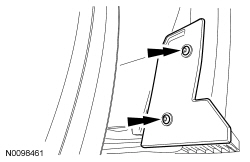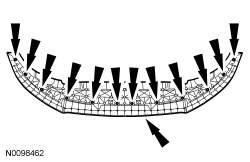SECTION 303-03B: Supercharger Cooling
| 2014 Mustang Workshop Manual
|
GENERAL PROCEDURES
| Procedure revision date: 01/07/2013
|
Supercharger Cooling System Draining, Filling and Bleeding
Special Tool(s)
 | Airlift Cooling System Tester
UVU550000 or equivalent
|
Material
| Item
| Specification
|
|---|
Motorcraft® Orange Antifreeze/Coolant Concentrated
VC-3-B (US); CVC-3-B2 (Canada)
| WSS-M97B44-D
|
Motorcraft® Orange Antifreeze/Coolant Prediluted
VC-3DIL-B (US); CVC-3DIL-B (Canada)
| WSS-M97B44-D2
|
Draining
 WARNING: Always allow the engine to cool before opening the cooling system. Do not unscrew the coolant pressure relief cap when the engine is operating or the cooling system is hot. The cooling system is under pressure; steam and hot liquid can come out forcefully when the cap is loosened slightly. Failure to follow these instructions may result in serious personal injury.
WARNING: Always allow the engine to cool before opening the cooling system. Do not unscrew the coolant pressure relief cap when the engine is operating or the cooling system is hot. The cooling system is under pressure; steam and hot liquid can come out forcefully when the cap is loosened slightly. Failure to follow these instructions may result in serious personal injury.
NOTICE:
Recover the coolant in a suitable, clean container for reuse. If the coolant is contaminated, recycle or dispose of it correctly. Using contaminated coolant may result in damage to the cooling system components.
NOTICE:
The
cooling system is filled with Motorcraft® Orange Antifreeze/Coolant. Mixing coolant types degrades the corrosion protection of Motorcraft® Orange Antifreeze/Coolant.
NOTE:
Dirty, rusty or contaminated coolant requires replacement.
- With the vehicle in NEUTRAL, position it on a hoist. Refer to
Section 100-02
.
- Remove the 9 bolts and the lower splash shield.
NOTE:
RH shown, LH similar.
Remove the 2 RH and the 2 LH screws.
- Remove the 12 bolts and the front bumper cover lower valance.
- Disconnect the radiator-to-
hose from the radiator and allow the coolant to drain in a suitable container.
Filling and Bleeding with a Vacuum Cooling System Refiller
- Connect the radiator-to-
hose to the radiator.
- Install the front bumper cover lower valance and the 12 bolts.
NOTE:
RH shown, LH similar.
Install the 2 RH and the 2 LH screws.
- Install the lower splash shield and the 9 bolts.

NOTICE:
Engine coolant provides boil protection, corrosion protection, freeze protection, and cooling efficiency to the engine and cooling components. In order to obtain these protections, maintain the engine coolant at the correct concentration and fluid level in the degas bottle.
To maintain the integrity of the coolant and the cooling system:
- Add Motorcraft® Orange Antifreeze/Coolant or equivalent. Do not mix coolant types.
- Do not add or mix with any other type of engine coolant. Mixing coolants may degrade the coolant's corrosion protection.
- Do not add alcohol, methanol, or brine, or any engine coolants mixed with alcohol or methanol antifreeze. These can cause engine damage from overheating or freezing.
- Ford Motor Company does NOT recommend the use of recycled engine coolant in vehicles originally equipped with Motorcraft® Orange Antifreeze/Coolant since a Ford-approved recycling process is not yet available.
NOTICE:
Stop-leak style pellets/products must not be used as an additive in this engine cooling system. The addition of stop-leak style pellets/products can clog or damage the cooling system resulting in degraded cooling system performance and/or failure.
Install the vacuum cooling system filler and follow the manufacturer's instructions to fill and bleed the cooling system.
When adding or topping off the engine coolant:
- Measure the coolant concentration in the vehicle using Coolant/Battery Refractometer 300-ROB75240 or equivalent.
- Determine the concentration desired based on the vehicle duty cycle of extreme hot or cold operating conditions.
- Add/top off or adjust the coolant as follows:
- For concentrations measured 48/52 to 50/50 (equates to a freeze point between -34°C (-30°F) and -37°C (-34°F)), use Motorcraft® Orange Antifreeze/Coolant Prediluted to maintain a coolant concentration in this same range.
- For all other concentrations, use Motorcraft® Orange Antifreeze/Coolant Concentrated and/or distilled water to get to the desired concentration.
- When refilling the engine coolant after a flush procedure, use a mixture of Motorcraft® Orange Antifreeze/Coolant Concentrated and distilled water to get to the desired concentration.
- Recommended coolant concentration is 48/52 to 50/50 (freeze protection -34°C (-30°F) and -37°C (-34°F)) engine coolant to distilled water.
- For extremely cold climates (less than -37°C (-34°F):
- It may be necessary to increase the coolant concentration above 50%.
- NEVER increase the coolant concentration above 60%.
- Maximum coolant concentration is 60/40 for cold weather areas.
- A coolant concentration of 60% provides freeze point protection down to -50°C (-58°F).
- Engine coolant concentration above 60% will decrease the overheat protection characteristics of the engine coolant and may damage the engine.
- For extremely hot climates:
- It is still necessary to maintain the coolant concentration above 40%.
- NEVER decrease the coolant concentration below 40%.
- Minimum coolant concentration is 40/60 for warm weather areas.
- A coolant concentration of 40% provides freeze point protection down to -34°C (-30°F).
- Engine coolant concentration below 40% will decrease the corrosion and freeze protection characteristics of the engine coolant and may damage the engine.
- Vehicles driven year-round in non-extreme climates should use a 48/52 to 50/50 (freeze protection -34°C (-30°F) and -37°C (-34°F)) mixture of engine coolant and distilled water for optimum cooling system and engine protection.

- Install the vacuum cooling system refiller and follow the manufacturer's instructions to fill and bleed the cooling system.
Filling and Bleeding without a Vacuum Cooling System Refiller
NOTICE:
Coolant provides boil protection, corrosion protection, freeze protection, and cooling efficiency to the engine and cooling components. In order to obtain these protections, maintain the engine coolant at the correct concentration and fluid level in the degas bottle.
To maintain the integrity of the coolant and the cooling system:
- Add Motorcraft® Orange Antifreeze/Coolant or equivalent. Do not mix coolant types.
- Do not add or mix with any other type of engine coolant. Mixing coolants may degrade the coolant's corrosion protection.
- Do not add alcohol, methanol, or brine, or any engine coolants mixed with alcohol or methanol antifreeze. These can cause engine damage from overheating or freezing.
- Ford Motor Company does NOT recommend the use of recycled engine coolant in vehicles originally equipped with Motorcraft® Orange Antifreeze/Coolant since a Ford-approved recycling process is not yet available.
NOTICE:
Do not use stop-leak style pellets/products as an additive in this engine cooling system. The addition of stop-leak style pellets/products can clog or damage the cooling system resulting in degraded cooling system performance and/or failure.
- Connect the radiator-to-
hose to the radiator.
- Install the front bumper cover lower valance and the 12 bolts.
NOTE:
RH shown, LH similar.
Install the 2 RH and the 2 LH screws.
- Install the lower splash shield and the 9 bolts.

NOTE:
Make sure the coolant flows from the radiator through the upper radiator hose and fills the engine. When full, coolant should flow from the bleed hole.
Fill the system through the degas bottle.
When adding or topping off the engine coolant:
- Measure the coolant concentration in the vehicle using Coolant/Battery Refractometer 300-ROB75240 or equivalent.
- Determine the concentration desired based on the vehicle duty cycle of extreme hot or cold operating conditions.
- Add/top off or adjust the coolant as follows:
- For concentrations measured 48/52 to 50/50 (equates to a freeze point between -34°C (-30°F) and -37°C (-34°F)), use Motorcraft® Orange Antifreeze/Coolant Prediluted to maintain a coolant concentration in this same range.
- For all other concentrations, use Motorcraft® Orange Antifreeze/Coolant Concentrated and/or distilled water to get to the desired concentration.
- When refilling the engine coolant after a flush procedure, use a mixture of Motorcraft® Orange Antifreeze/Coolant Concentrated and distilled water to get to the desired concentration.
- Recommended coolant concentration is 48/52 to 50/50 (freeze protection -34°C (-30°F) and -37°C (-34°F)) engine coolant to distilled water.
- For extremely cold climates (less than -37°C (-34°F):
- It may be necessary to increase the coolant concentration above 50%.
- NEVER increase the coolant concentration above 60%.
- Maximum coolant concentration is 60/40 for cold weather areas.
- A coolant concentration of 60% provides freeze point protection down to -50°C (-58°F).
- Engine coolant concentration above 60% will decrease the overheat protection characteristics of the engine coolant and may damage the engine.
- For extremely hot climates:
- It is still necessary to maintain the coolant concentration above 40%.
- NEVER decrease the coolant concentration below 40%.
- Minimum coolant concentration is 40/60 for warm weather areas.
- A coolant concentration of 40% provides freeze point protection down to -34°C (-30°F).
- Engine coolant concentration below 40% will decrease the corrosion and freeze protection characteristics of the engine coolant and may damage the engine.
- Vehicles driven year-round in non-extreme climates should use a 48/52 to 50/50 (freeze protection -34°C (-30°F) and -37°C (-34°F)) mixture of engine coolant and distilled water for optimum cooling system and engine protection.
- Start the engine and allow to run until coolant circulation is observed in the degas bottle. Absence of circulation indicates air is trapped in the system.
- Add coolant as needed.
- Repeat the above procedure to make sure all entrapped air is released.


 WARNING: Always allow the engine to cool before opening the cooling system. Do not unscrew the coolant pressure relief cap when the engine is operating or the cooling system is hot. The cooling system is under pressure; steam and hot liquid can come out forcefully when the cap is loosened slightly. Failure to follow these instructions may result in serious personal injury.
WARNING: Always allow the engine to cool before opening the cooling system. Do not unscrew the coolant pressure relief cap when the engine is operating or the cooling system is hot. The cooling system is under pressure; steam and hot liquid can come out forcefully when the cap is loosened slightly. Failure to follow these instructions may result in serious personal injury.









